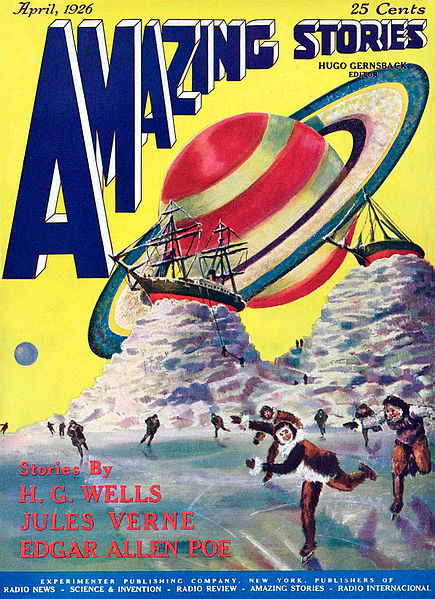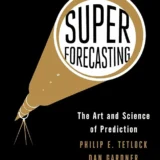 Eighty-Eight years ago, the first issue* of Amazing Stories – a ‘new sort of magazine’ – was probably just finishing up at the printers. It would be a few more days before it would be shipped out to take its place on the magazine racks and newsstands peppered across New York City, Chicago, Los Angeles, San Francisco, Boston, Dallas and, eventually far-flung places like London and Paris.
Eighty-Eight years ago, the first issue* of Amazing Stories – a ‘new sort of magazine’ – was probably just finishing up at the printers. It would be a few more days before it would be shipped out to take its place on the magazine racks and newsstands peppered across New York City, Chicago, Los Angeles, San Francisco, Boston, Dallas and, eventually far-flung places like London and Paris.
Eighty-Eight years ago, scientifiction** became a thing.
Within its first year, Amazing Stories would achieve a circulation of over one hundred thousand copies. Whether or not that number is total copies printed less returns or inclusive of returns, it is still a very impressive number for a niche market magazine. The population of the United States in 1926 was approximately 117 millions: 1 copy for every 1,170 citizens.
Today, the print magazines have distribution of fewer than 20 thousand copies (some far fewer), while the population itself has more than quadrupled. True, most of the SF magazine activity has moved on line, but if we consider “unique views” to be the rough equivalent of subscriptions, none of them (including Amazing) are doing better than double that.
So what’s the difference between then and now? What did Hugo know that we didn’t?
I don’t know and I’m not sure, but I do see one major difference. In 1926, the people of the United States were looking forward to the future. Despite a looming financial crisis and another war in Europe that would start within a decade, the US was all about technological advancement and the wondrous futures they portended; radio was becoming ubiquitous, television was being flirted with, the possibilities of rocketry and atomic power were on the drawing board, powered flight was being perfected and electricity was lighting up the country. It seemed that every single day brought the announcement of a new labor saving, life enhancing, productivity improving invention.
In many respects, 1926 was not all that different from 2014: every day we learn of a new technological advance, another scientific discovery; financial crisis loom and war (though on a smaller scale) is rampant across the globe.
Yet we don’t seem to look forward to our future in the same ways we once did.
Perhaps one contributing factor is the major difference between your average citizen then and now: the cost of living was far less and average incomes were proportionally greater. A monthly pulp magazine cost anywhere from a dime to a quarter; movies were a nickel; a Manhattan apartment within commuting distance of Wall Street averaged about $200 per month and average income across the entire country was about $1300 per year (while in Manhattan, the average income claimed on tax returns was over $5,000). Back then, buying a dime magazine once a month ($1.20) meant you were spending .0009 percent of your income on pulp entertainment. (And as folks like Frederik Pohl have informed us, you could also buy remaindered copies for far less than the cover price – if you were willing to wait.)
Today, cover prices are $7.99, average incomes are (for 2012) about $51,000. Your cost to keep up with one monthly “pulp” has now risen to .002 percent of your income. And when you consider that most everything else required to let you enjoy your monthly read has increased in cost (percentage of income) by a similar or greater amount, it is not difficult at all to see why reader participation has seemed to drop off significantly.
I suspect that there is no lack of desire. rather it’s the sadly simple fact that in order to get by, your average science fiction fan just can’t afford to engage with the future anymore – or at least not as much as they once did. The increase in sales of low-cost electronic alternatives and the popularity of free content would seem to bear this out.
Which possibility raises another observation: if we’re not getting inspired about the future on a regular basis, if we can’t go there and report back on how marvelous, awe-inspiring and exciting it is (and will be), it becomes very easy to fall under the sway of our moribund zeitgeist. There are no alternative views capable of erasing the BS that fills our eyeballs from the television every day.
If you can’t believe that you will be a beneficiary of the wonderful futures to come, why bother torturing yourself with visions of things you’ll never own, never experience, never participate in?
I think it’s a good question. One that makes me think about supporting the calls for an increased minimum wage, a New Deal style works program and an increase in NASA’s budget.
If we are going to have a future we want to live in, we need to have vision and if we are going to have vision, we need people to believe they can actually participate in and benefit from that future. Being able to afford to read about it once a month is a small but important step in that direction.
***
For some interesting visions of a future, take a gander at a recent post from FuturesPastEditions that reprints celebrity predictions of 2001 for the 30th anniversary issue of Amazing Stories (1956).
*Although the first issue of Amazing Stories bears a cover date of April, 1926, it was actually distributed in March of that year, a practice that remains in place today with most magazines distributed to retail outlets.
**Hugo Gernsback’s portmanteau of scientific fiction. Science Fiction itself would not be named on the cover of an SF magazine for another 7 years.
Steve Davidson is the publisher of Amazing Stories.
Steve has been a passionate fan of science fiction since the mid-60s, before he even knew what it was called.










Happy Birthday, Amazing Stories!
It seems to me that what Hugo had was an ability to stir things up that is lacking today. His magazine had a stirring impact on people and they wanted to see what it was about. Also, he did not run into the disapproval factor, which took awhile to build up.
I assume that’s the first issue you’ve displayed. Thanks for showing it.
John,
yes, that’s a pic of the APRIL, 1926, volume 1 number 1, whole number 1, issue of Amazing Stories. The Frank R. Paul cover illustrates Verne’s Off On A Comet. I have it on good historical authority that (as is typical for magazines – or at least used to be) actual distribution took place in the month prior to the cover date. Modern mags are often on the stands anywhere from two weeks to three months prior to their cover dates.